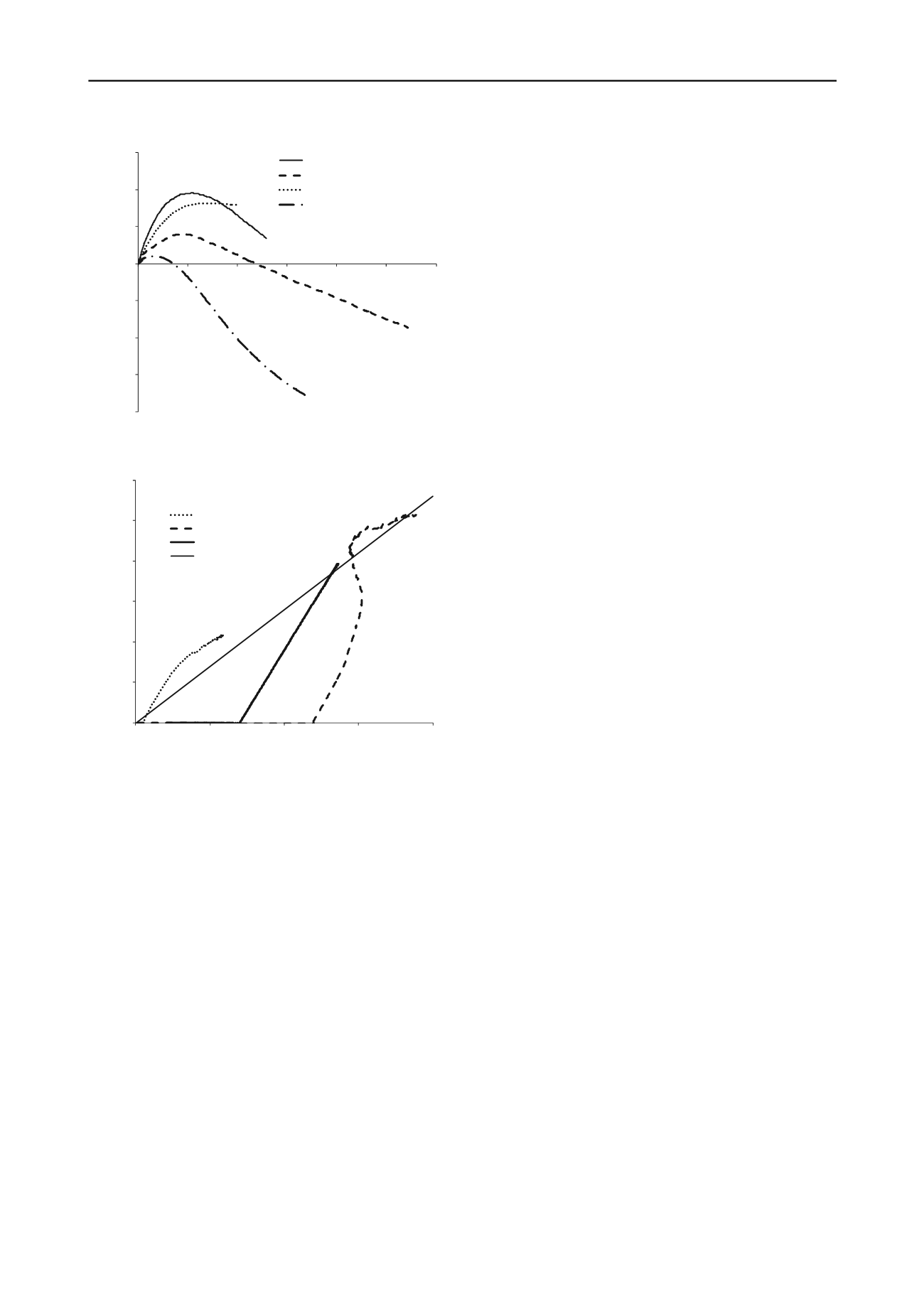
304
Proceedings of the 18
th
International Conference on Soil Mechanics and Geotechnical Engineering, Paris 2013
Proceedings of the 18
th
International Conference on Soil Mechanics and Geotechnical Engineering, Paris 2013
The results also suggest that SMA has a lower residual
strength than DAC once the aggregate structure is disturbed at
slow rates of loading. This is in direct contradiction to how the
SMA product is supposed to perform at high rates of loading,
which is to have better resistance to permanent deformation.
This difference in behaviour at higher loading rates could be
related to the much greater sensitivity of the SMA to changes in
loading rate which has been observed in the triaxial tests. This is
also consistent with the greater influence of the bitumen in the
SMA tests than for the DAC.
-0.040
-0.030
-0.020
-0.010
0.000
0.010
0.020
0.030
0
0.05
0.1
0.15
0.2
0.25
0.3
Volume strain
Axial strain
SMAaggregateonly,p'c = 500 kPa
SMAp'c = 700 kPa
DAC aggregateonly,p'c = 500 kPa
DAC p'c = 700 kPa
3 CONCLUSION
Conventional soil mechanics triaxial tests have been conducted
on saturated asphalt specimens. These have shown that the
behaviour of the asphalt can be very sensitive to details of the
aggregate grading. For dense asphaltic concrete, which has a
well-graded aggregate and 5% bitumen, the behaviour in slow
triaxial tests is controlled by the aggregate particles, and the
bitumen appears to have little effect. For the stone mastic
asphalt, which has a gap-graded aggregate and 6% bitumen, the
bitumen has a significant effect on the stress-strain-strength
behaviour.
Figure 7. Comparison of volume changes for SMA and DAC.
0
500
1000
1500
2000
2500
3000
0
500
1000
1500
2000
Deviator stress, q (kPa)
Mean effective stress, p' (kPa)
Undrained p'c=50 kPa
Undrained p'c=1200kPa
Drained p'c= 700kPa
M= 1.4
The sensitivity of the asphalt to relatively minor changes in
grading and bitumen content is a surprising result, and further
tests are in progress to help understand the mechanisms
responsible for this behaviour.
4 ACKNOWLEDGEMENTS
The authors are grateful to the Roads and Maritime Services
(NSW) for supplying the asphalt specimens and materials used
in this study.
5 REFERENCES
Antes, PW, Van Dommelen, AE, Houben, LJM, Molenaar, AA and
Parajuli, U (2003) Stress dependent behaviour of asphalt mixtures
at high temperatures,
Proceedings of the Technical Sessions
, v 72,
p 173-195,
Asphalt Paving Technology
.
Figure 8. Effective stress paths of SMA specimens.
similar aggregate void ratios. Although the lower strength of the
SMA specimen is consistent with the reduced dilation, this does
not explain the very much lower mobilized frictional resistance
of the SMA specimen, which can be seen from the plot of the
effective stress paths of the drained test, and two undrained tests
of SMA, shown in Figure 8. Figure 8 shows the mobilized stress
ratio for the tests at the higher stress levels is 1.4, corresponding
to a friction angle of 34.6
o
. This is significantly less than the
friction angle of the aggregate which is expected to be 41
o
,
similar to the DAC aggregate because the material is the same
and the grading is not that different.
Li, P, Liu, J and Saboundjian, S. (2010) Materials and temperature
effects on the resilient response of asphalt-treated Alaskan base
course materials,
Journal of Materials in Civil Engineering
, 23, 2,
p. 161-168.
Muraya, PM, Molenaar AAA and van de Ven MFC (2012)
Contribution of the bituminous mortar and stone skeleton to the
resistance to permanent deformation in Asphalt mixtures, Journal of
Testing and Evaluation, 37, 5, 1-7.
Roads and Maritime Services(RMS) (2010), R121. QA Specifications,
Stone Mastic Asphalt, Ver. 2.1 NSW , Australia.
Roads and Maritime Services(RMS) (2012) R116. QA Specifications,
Dense GradedAsphalt, Ver. 8.2 NSW, Australia.
It can be seen that the SMA specimens mobilize a
significantly lower resistance than the DAC specimens, even
though they have mostly the same aggregate material with the
same frictional characteristics. The differences between the two
asphalt materials include: the gap grading of the SMA
aggregate; the slightly higher bitumen content in the SMA; and
the presence of a small amount of cellulose fibres in the SMA
mix. The presence of fibres would be expected to provide some
additional strength to the asphalt mix, and there was no
evidence that they had a significant effect on the aggregate only
mixture, so the fibres do not appear to be responsible for the
difference in behaviour. It thus appears that in SMA the
bitumen is interacting with the fine particles and acting to
minimize the frictional interaction of the larger aggregate. In
contrast in the well graded DAC there appears to be sufficient
interaction between the larger aggregate particles so that the
bitumen acts independently of the particle structure.


